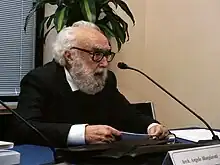Angelo Mangiarotti
Angelo Mangiarotti (26 February 1921 – 2 July 2012) was an Italian architect and industrial designer. His designs were mostly for industrial buildings and railway stations.[2] In 1994 he received the Compasso d'Oro award of the Associazione per il Disegno Industriale for his lifetime of achievement.[3]
Angelo Mangiarotti | |
|---|---|
 | |
| Born | 1921 Milan, Italy |
| Died | 2 July 2012[1] (aged 91) Milan |
| Nationality | Italian |
| Occupation | architect |

Life and work

Mangiarotti was born in Milan in 1921. He studied architecture at the Politecnico di Milano, graduating in 1948.[3]
In 1953 he was a visiting professor at the Design Institute of the Illinois Institute of Technology. While in Chicago he came into contact with Frank Lloyd Wright, Walter Gropius, Ludwig Mies van der Rohe and Konrad Wachsmann.[3]
From 1955 to 1960 he had an architectural and design studio in Milan in partnership with Bruno Morassutti,[2][3] and in 1965 was among the founding members of the Associazione per il Disegno Industriale.[2] He held a number of teaching positions, many of them outside Italy. In 1989 he established an architectural practice in Tokyo.[2]
In 1994 he received the Compasso d'Oro award of the Associazione per il Disegno Industriale for his lifetime of achievement.[3]
Work

His architectural work included many industrial buildings, among them projects in Padova in 1959, in Marcianise and in Mestre in 1962, in Monza in 1964, and in Cinisello Balsamo in 1973.[2] He also designed a number of railway stations, among them the Milano Certosa and Milano Rogoredo for the Ferrovie dello Stato between 1982 and 1988, and the Porta Venezia and Repubblica stations on the Passante Ferroviario di Milano between 1983 and 1996.[2] Among his other projects were the offices and exhibition space for Snaidero in Majano in Friuli-Venezia Giulia in 1978, and the exhibition centre for the Internazionale Marmi e Macchine – the organisation behind the Fiera Internazionale Marmi e Macchine di Carrara trade fair – in 1992 and 1993.[2]
Books
His book In nome dell'architettura was published by Jaca Book in Milan in 1987.[2]
References
- 'Liz' (2 July 2012). L'ultimo saluto a Angelo Mangiarotti (in Italian). Milan: Corriere della Sera. Archived 6 July 2012.
- Mangiaròtti, Angelo (in Italian). Enciclopedia on line. Roma: Istituto dell'Enciclopedia Italiana. Accessed September 2022.
- Angelo Mangiarotti: È scomparso a Milano il 2 luglio Angelo Mangiarotti, una delle figure centrali dell'architettura e del design italiano della seconda metà del novecento, socio onorario di ADI (in Italian). Associazione per il Disegno Industriale. Accessed September 2022
Further reading
- Various Authors, "Maestri del Design. Castiglioni, Magistretti, Mangiarotti, Mendini, Sottsass", Bruno Mondadori, 2005
- Toto – Gallery MA, "Angelo Mangiarotti, un percorso-MA-un incontro", Tokyo, 2004
- Beppe Finessi, "su Mangiarotti – architettura, design, scultura", Abitare Segesta Cataloghi, 2002
- Luciano Caramel, "Il DNA della scultura. Angelo Mangiarotti", Internazionale Marmi e Macchine Carrara, 1999
- Francois Burkhardt, "L'aspetto artistico nell'opera di Mangiarotti", Domus, n.807, September 1998, pp. 104–110
- Thomas Herzog (Ed.), "Bausysteme von Angelo Mangiarotti", Verlag Das Beispiel GmbH, Darmstadt, 1998
- Guido Nardi, "Angelo Mangiarotti", Maggioli Editore, Rimini, 1997
- Enrico D. Bona, "Mangiarotti", Sagep, Genova, 1988
- Angelo Mangiarotti, M.Luchi, L.Bonesio, L.Magnani, "In nome dell'architettura", Jaca Book, Milano, 1987
- Enrico D. Bona, "Angelo Mangiarotti: il processo del costruire", Electa, Milano, 1980
- Ichiro Kawahara, "Angelo Mangiarotti 1955–1964", Seidoh-Sya Publishing Co., Tokyo, 1964